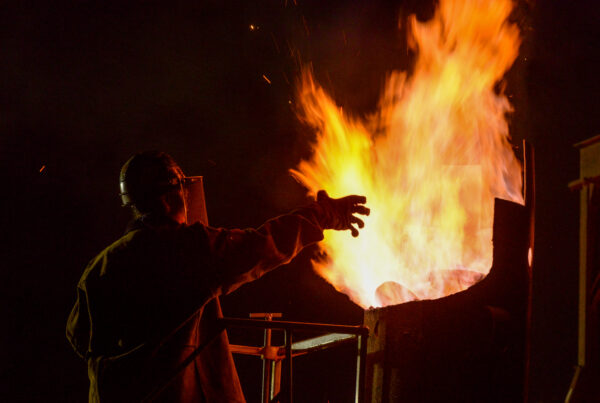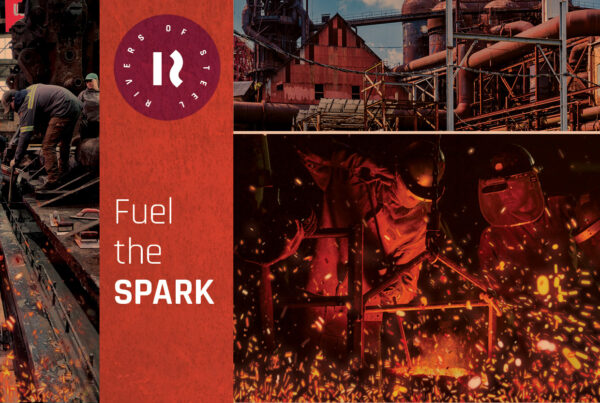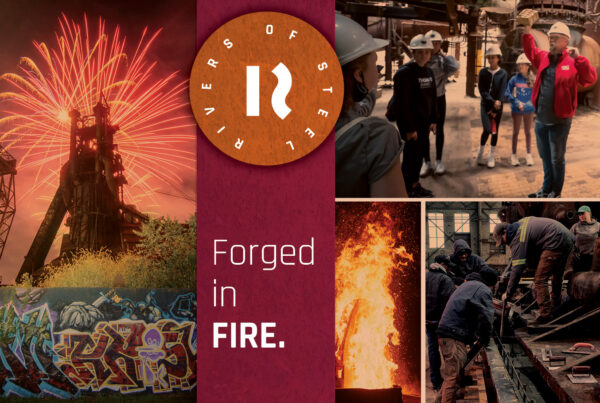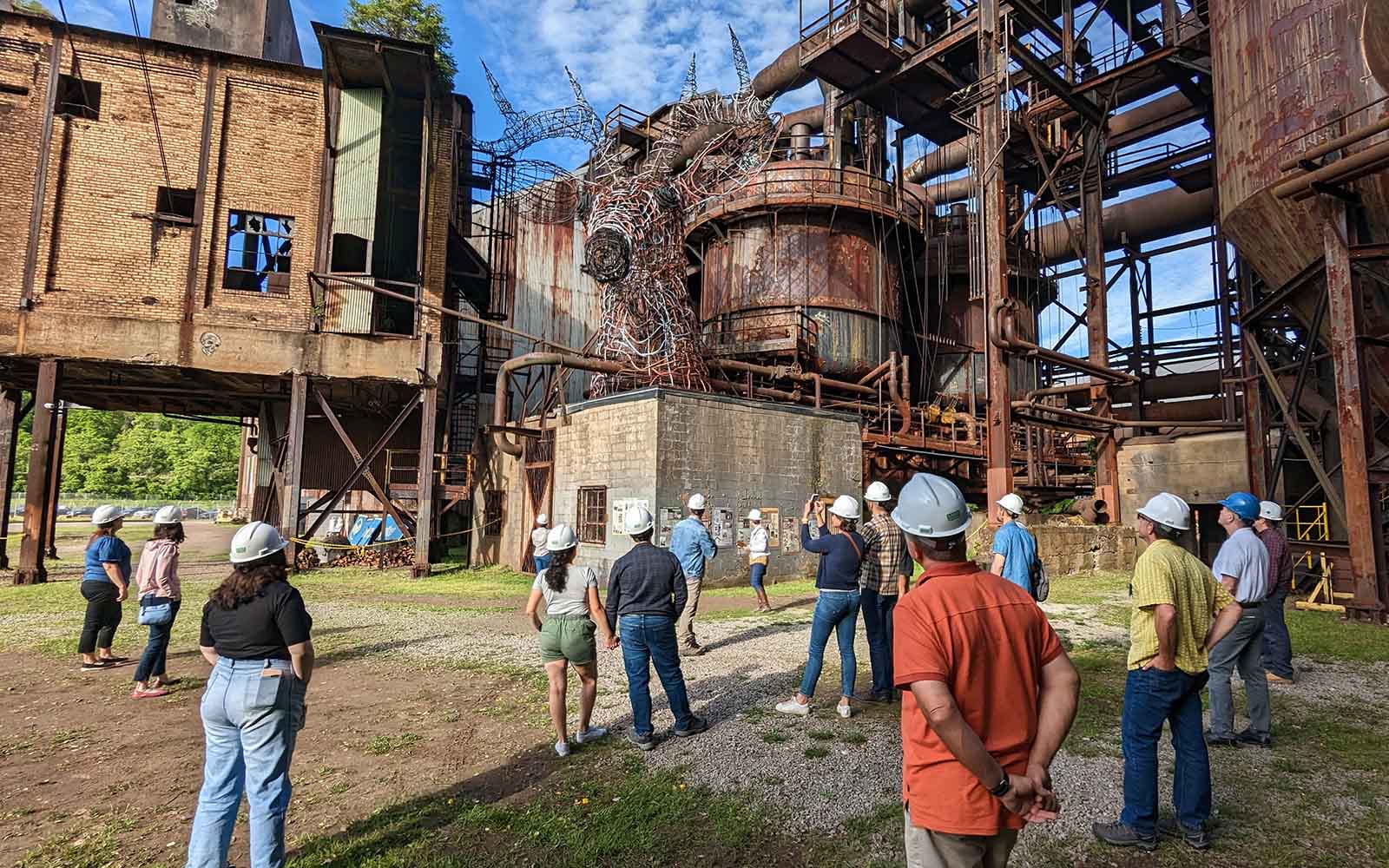
Guests of the Green Building Alliance take a tour of the Carrie Furnaces that examines how the site is sustainably repurposed, May 25, 2023.
A Sustainable Look at the Arts and Grounds of the Carrie Furnaces
Recently, Rivers of Steel collaborated with the Green Building Alliance to weave two divergent narratives at Carrie—its industrial and the postindustrial stories—into a unified thread that reflects the sustainable approach our organization brings to the development of the historic site.
By Jordan Snowden
A Second Life, By Chance
Over a year of Sundays from 1997 to 1998, a group dubbed the Industrial Arts Co-op broke into the grounds of the Carrie Blast Furnaces, now a National Historic Landmark, and slowly but deliberately crafted a forty-five-foot-tall deer head structure out of discarded found objects—steel tubing and structural metals, copper wire, and rubber hose.
Called the Rankin Deer at the time, the artists were inspired by the way nature was reclaiming the abandoned site. It had only been a little over a decade since the former iron mill had been largely stripped by scrappers and left to languish, and already plant and wildlife were taking charge. The collective embraced that concept—one that brings to light human beings’ use of something for their own benefit, only to turn away when it no longer serves to be profitable—to showcase evolution and an inevitable return to nature.
They thought their art would be temporary, making it not for public consumption but simply for the artists’ sake. Their thinking was that the Rankin Deer, also known as the Carrie Deer, would be torn down and bulldozed over like the rest of the site eventually would. But the Industrial Arts Co-op, made up of George Davis, Liz Hammond, Tim Kaulen, John Latell, Joe Small, Tim Yohman, and Bob Ziller, was unknowingly changing the course of history and the fate of the Carrie Blast Furnaces. They were seeding the site with a second life.

Tour guide Andy Schneider orients the Green Building Alliance guests to the Carrie Blast Furnaces.
Sustainability, Multiple Ways
On a sunny Thursday evening toward the end of May, the Green Building Alliance (GBA), a Pittsburgh-based nonprofit focusing on supporting sustainable buildings and community, explored the postindustrial site, located in both Swissvale and Rankin, for a special tour merging the historical, industrial aspects of the Carrie Furnaces narrative and its art-rooted resurgence that Rivers of Steel has fostered over the last decade.
“Much of our work with various stakeholders involves nurturing both supply and demand of healthier, higher-performing buildings—and we love to use inspiration as a motivating force,” explained Leslie Montgomery, Vice President of Education & Communications at GBA. “One of our favorite ways to accomplish this is through building tours to show people what is possible, and often we’ll have contractors and architects showing people how they achieved their green buildings or owners / operators will describe their efficiency updates. We also really love to showcase historic properties and talk about how preservation plays into sustainability.”

Patrick Camut’s sculpture Stan, which features a fulcumb, speaks to how his grandfather balanced his life working in steel, sometimes quite literally when he drove to work with a coffee mug balanced during the ride. The artwork is now a permanent feature at the Carrie Blast Furnaces.
In the case of the furnaces, the tour not only spoke to Pittsburgh’s regional culture and history, alongside Rivers of Steel’s role in preservation, but showcased the Carrie Blast Furnaces as a shining example of one of the many ways a location can be sustainable without technical upgrades or significant changes.
“GBA does a lot of green building tours, a lot of times single buildings, but because of the nature of Pittsburgh, there are a lot of sites like Carrie that were once industrial and are now being repurposed that are of interest to us,” Montgomery said. “In the world of the built environment, when you’re reusing something that’s already there, that’s more sustainable than doing something new.”
This is true particularly in Pittsburgh, where many contaminated industrial sites were remediated into usable brownfields to be repurposed. One example is Hazelwood’s Mill 19, a previous steel mill location now being used for housing and commercial use.
“But at Carrie Furnaces, it’s so interesting because they’re just using it in its state, and they’re using it as an arts and cultural center, which is very unique,” said Montgomery. “Especially because it sounds like that’s what people went in and used it for.”
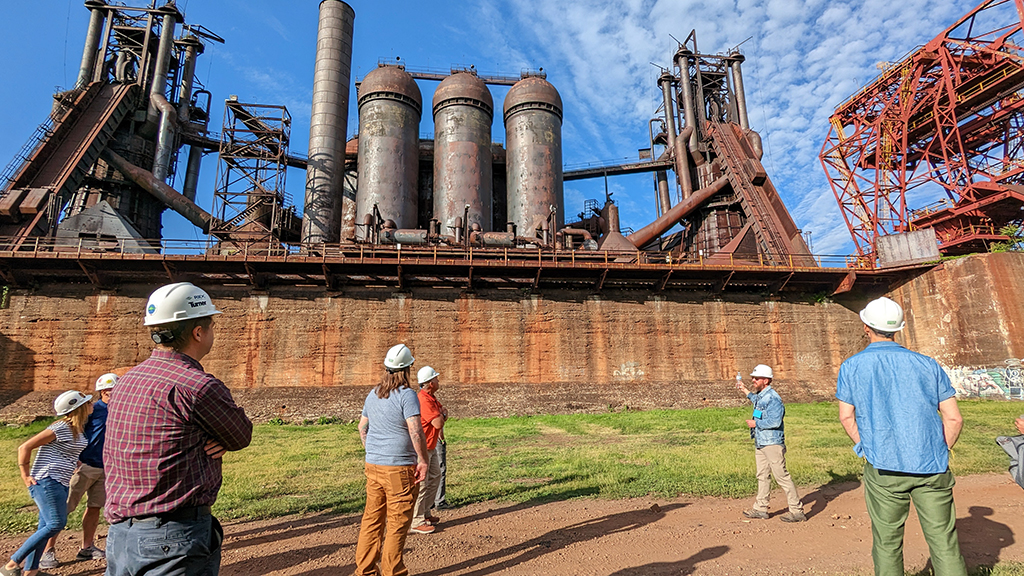
While graffiti writing and spray can murals are allowed in designated places, the Carrie Furnaces proper are off-limits. The historical graffiti at the base is being allowed to fade on its own.
Let’s Compromise . . . and Make Art Together
By the time Rivers of Steel began managing the Carrie Blast Furnaces, word had gotten out that some artists had broken into the dormant property and constructed a massive structure . . . and people from across the globe were interested in seeing it. At that time, in the mid-2000s, Rivers of Steel’s vision for the historic site was to focus on sharing its storied industrial heritage. The Carrie Deer added a different layer to the location and highlighted the multiple possibilities for what the site could become.
“The Carrie Deer opened us up to tell a postindustrial story,” explained Carly V. McCoy, Rivers of Steel’s Director of Marketing & Communications. “Carrie’s story doesn’t end in the early 1980s when the site went offline. As their ancestors had done before them, the next generation still came to mill, only they were looking for a new way to understand their place in the story. In a city without Big Steel, what was their destiny? Groups like the Industrial Arts Co-op, their graffiti-writer companions, and local youth, in general, had already begun their own reinterpretation of the site.”
Members of the Industrial Arts Co-op were not the only creatives to venture into the Carrie Furnaces over the years. Since its closure in the ’80s, the site became a hotbed for Pittsburgh graffiti artists to leave their mark on the former industrial space. When the site became a National Historic Landmark, this presented a challenge for Rivers of Steel. The culture of the site needed to be transformed to preserve the venerable structures. But instead of choosing to put up defenses, Rivers of Steel came up with a compromise: they fostered a collaborative relationship with the local artists. By offering up specific—and not historically designated—walls as canvases, the work of graffiti writers and street art muralists became a curated collection, featuring artists from across the globe. In doing so, they hoped to be able to curtail vandalism.
And it worked: stretching the length of the back edges of the Carrie Blast Furnaces are colorful, mostly temporary artworks, some of which are now third or fourth-generation pieces. Graffiti art became another part of Rivers of Steel’s unique draw; besides enjoying the murals, visitors to the historic site can participate in graffiti-based tours and workshops.
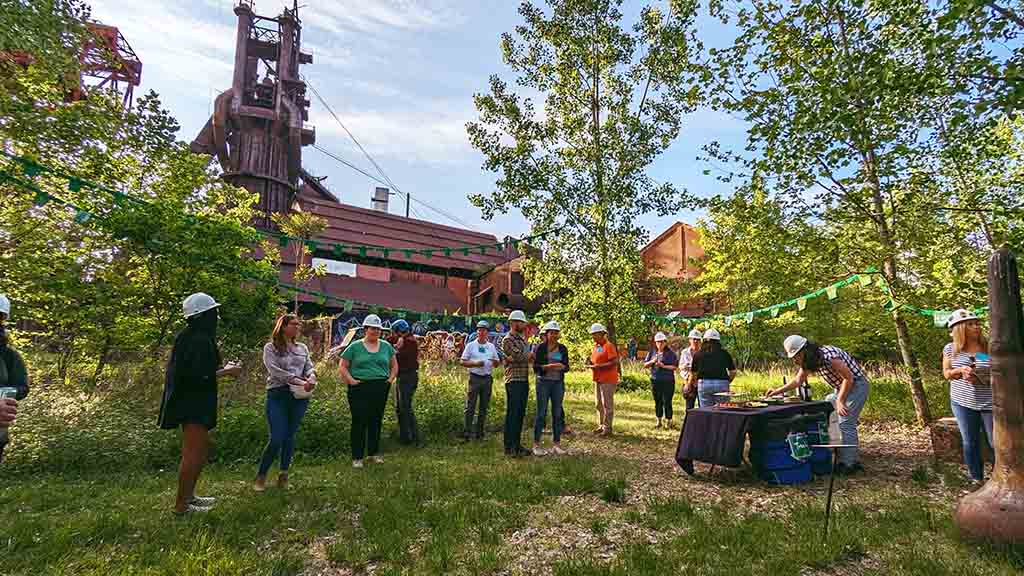
A clearing in the Iron Garden, called the Green Room, provides a place for reflection, and during this evening a place for a reception.
The Iron Garden—A Place for Reflection
As the tour concluded, the guests with the Green Building Alliance gathered for a reception in the shadow of Carrie Furnace #6. Along the eastern property line of the site, Rivers of Steel has allowed nature to (nearly) fully reclaim a stretch of land, with a path carved through it and a small clearing for reflection. Rather than planting in this garden, Rivers of Steel manages the natural growth with a light touch, allowing the story of nature’s resilience to shine through. Instead, the land has been seeded with sculptures and is currently adorned with an installation by Bradford Mumpower and Latika Sewell called Mini Greens 2. Dubbed the Iron Garden, the space resonates with the spirit of the Carrie Deer, a collaborative and organic journey that finds beauty in the unexpected.
“It’s an unbelievably interesting way to utilize the site in an additional capacity besides a bunch of nerds walking around talking about steel industry history,” said Andy Schneider, the tour guide for the evening.
Perhaps surprisingly to some visitors, the site is blossoming with connections between art, sustainability, and historic preservation.
 Jordan Snowden is a freelance writer based in Pittsburgh whose work has been published in The Seattle Times, Pittsburgh City Paper ,and elsewhere. She also runs @jord_reads_books, a book-focused Instagram account where she connects with other bookworms. In her free time, Jordan can be found with a book in her hand or DIYing something with her husband.
Jordan Snowden is a freelance writer based in Pittsburgh whose work has been published in The Seattle Times, Pittsburgh City Paper ,and elsewhere. She also runs @jord_reads_books, a book-focused Instagram account where she connects with other bookworms. In her free time, Jordan can be found with a book in her hand or DIYing something with her husband.

